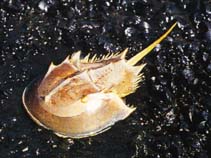Advertisement
Limulus polyphemus (Linnaeus, 1758)
Horseshoe crab| Native range | All suitable habitat | Point map | Year 2050 |

|
| This map was computer-generated and has not yet been reviewed. |
| Limulus polyphemus AquaMaps Data sources: GBIF OBIS |
country information
Common names:
[No common name]
Occurrence:
Salinity:
Abundance: | Ref:
Importance: | Ref:
Aquaculture: | Ref:
Regulations: | Ref:
Uses: no uses
Comments:
National Checklist:
Country Information:
National Fisheries Authority:
Occurrences: Occurrences Point map
National Database:
Occurrence:
Salinity:
Abundance: | Ref:
Importance: | Ref:
Aquaculture: | Ref:
Regulations: | Ref:
Uses: no uses
Comments:
National Checklist:
Country Information:
National Fisheries Authority:
Occurrences: Occurrences Point map
National Database:
Common names from other countries
Classification / Names Κοινά ονόματα | Συνώνυμα | Catalog of Fishes (gen., sp.) | ITIS | CoL | WoRMS
Environment: milieu / climate zone / depth range / distribution range Οικολογία
Distribution Χώρες | Περιοχές FAO | Οικοσυστήματα | Παρουσίες | Εισαγωγές
Western Atlantic: from Maine, USA to Mexico.
Length at first maturity / Μέγεθος / Weight / Age
Maturity: Lm ? range ? - ? cm Max length : 60.0 cm TL αρσενικό/απροσδιόριστο; (Αναφ. 82); μεγ. δημοσιευμένο βάρος: 1.8 kg (Αναφ. 82); μεγ. αναφερόμενη ηλικία: 20 έτη (Αναφ. 99652)
The males are approximately 1/3 the size of the females (sexual dimorphism) (Ref. 83). Lives in shallow waters, with sandy or muddy bottoms (Ref. 76). Found in intertidal and offshore areas (Ref. 1131). The horseshoe crab feeds at night on polychaete worms such as Cerebratulus, Nereis, and Cistenides (Ref. 76, 77), small mollusks, and seaweed (algae) found in the sandy ocean bottom (Ref. 76). Food is picked up by the chelicerae and passed back to the bristle bases, where it is "chewed." The food is then moved forward to the mouth (Ref. 75). It digs its food from sediments, grasping the prey with its legs. The prey is moved to the gnathobases where it is crushed before being pushed forward toward the mouth (Ref. 77). A life span of about 20 to 40 years (Ref. 78). Its predators are loggerhead turtles, pufferfish, leopard sharks and sea gulls (Ref. 82).
Life cycle and mating behavior Γεννητική Ωρίμανση | Αναπαραγωγή | Γεννοβολία | Eggs | Γονιμότητα | Larvae
They reproduce with the use of the first pair of the six, flap-like appendages on the underside of the abdomen acts as a cover for the genital pore. The egg or sperm are released through this pore during spawning (Ref. 75). These eggs are fertilized by sperm released by an attached male and by one or more satellite males that typically congregate around the nesting pair (Ref. 81). While nesting, females bury themselves in the sediment near the water's edge and lay a series of discrete egg clusters, each containing 2,000-20,000 eggs (Ref. 80).
Main reference
Αναφορές | Συντονιστής | Συνεργάτες
Lee, C.N. and B. Morton. 2005. (Αναφ. 1131)
IUCN Red List Status
(Αναφ. 130435: Version 2024-2)
Ευάλωτο, βλέπε Κόκκινη Λίστα (VU) (A3bd); Date assessed: 17 February 2016
CITES status (Αναφ. 108899)
Not Evaluated
CMS (Αναφ. 116361)
Not Evaluated
Threat to humans
Harmless
Human uses
αλιεία: Εμπορικό(ά)
FAO - αλιεία: landings | FIRMS (Stock assessments) | FishSource | Η θάλασσα γύρω μας
Εργαλεία
Περισσότερες πληροφορίες
Διαδικτυακές πηγές
BHL | BOLD Systems | CISTI | DiscoverLife | FAO(αλιεία: ; publication : search) | GenBank (genome, nucleotide) | GloBI | Gomexsi | Google Books | Google Scholar | Google | PubMed | Δέντρο Ζωής | Wikipedia (Go, αναζήτηση) | Zoological Record
Estimates based on models
Preferred temperature
(Ref. 115969): 12.5 - 28, mean 26.7 (based on 417 cells).




